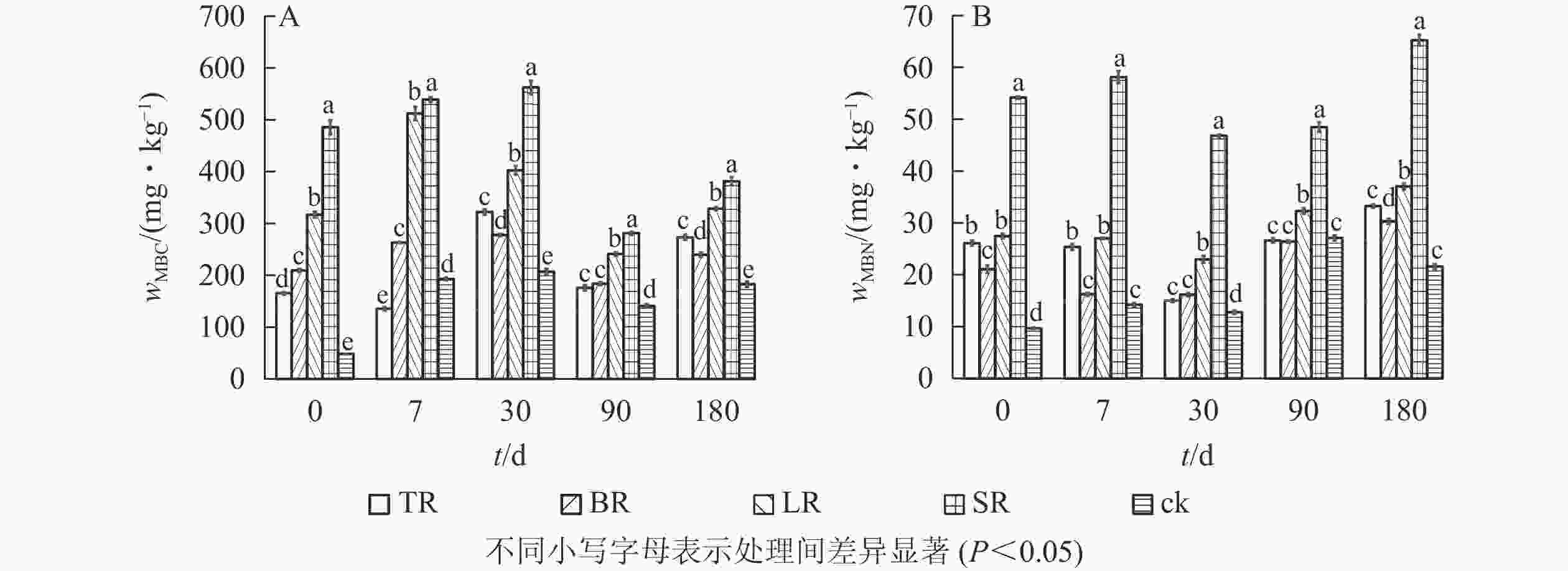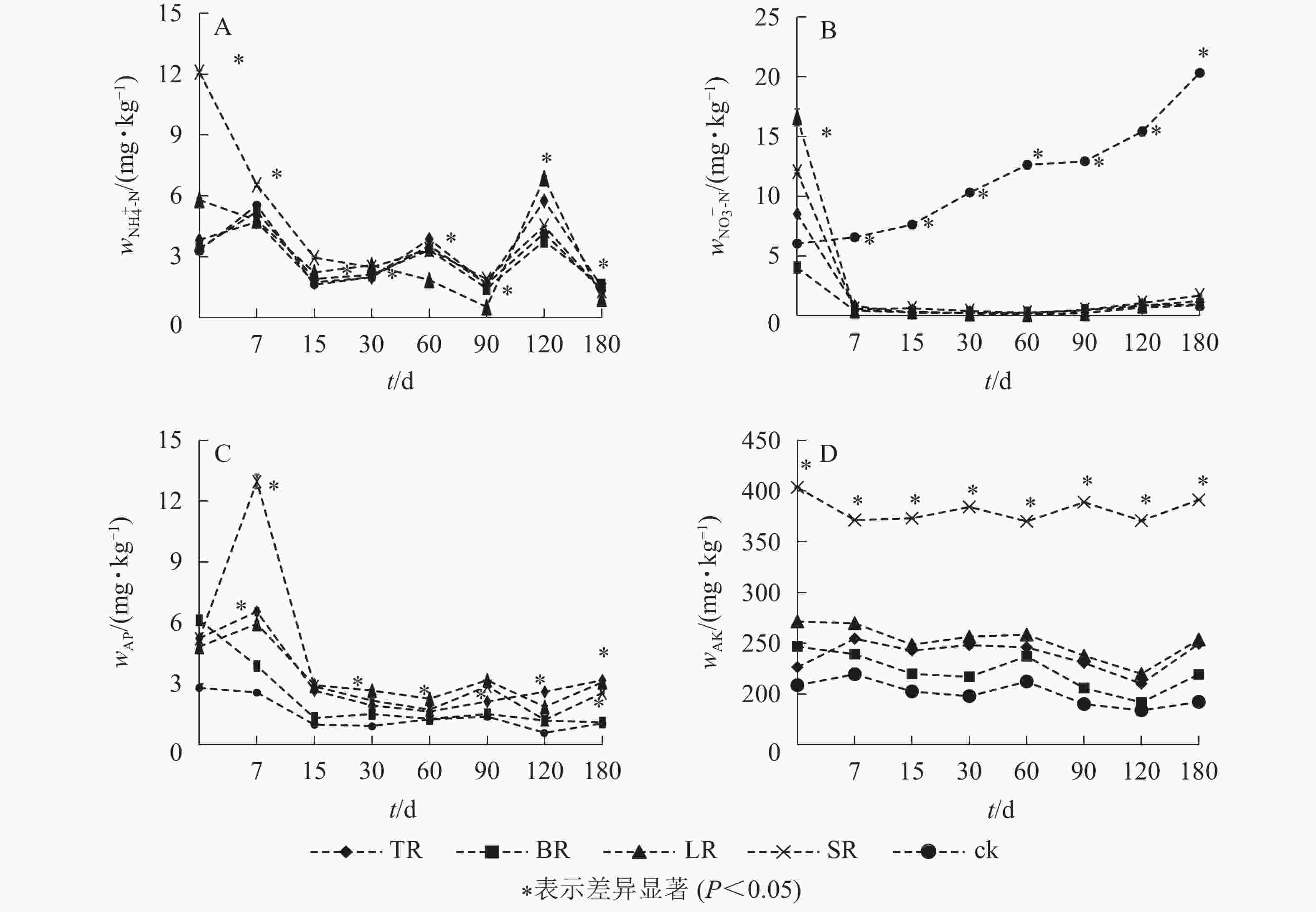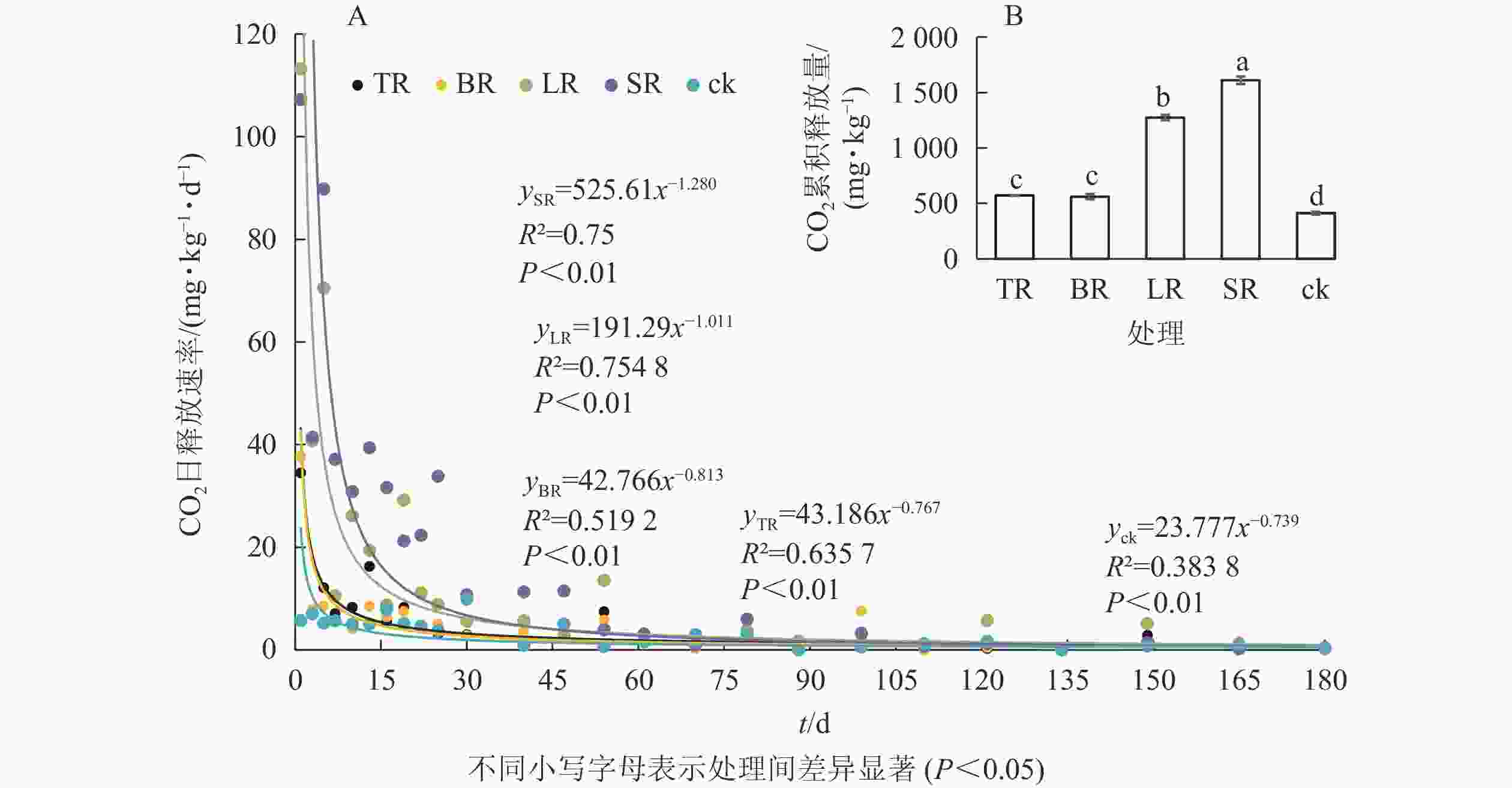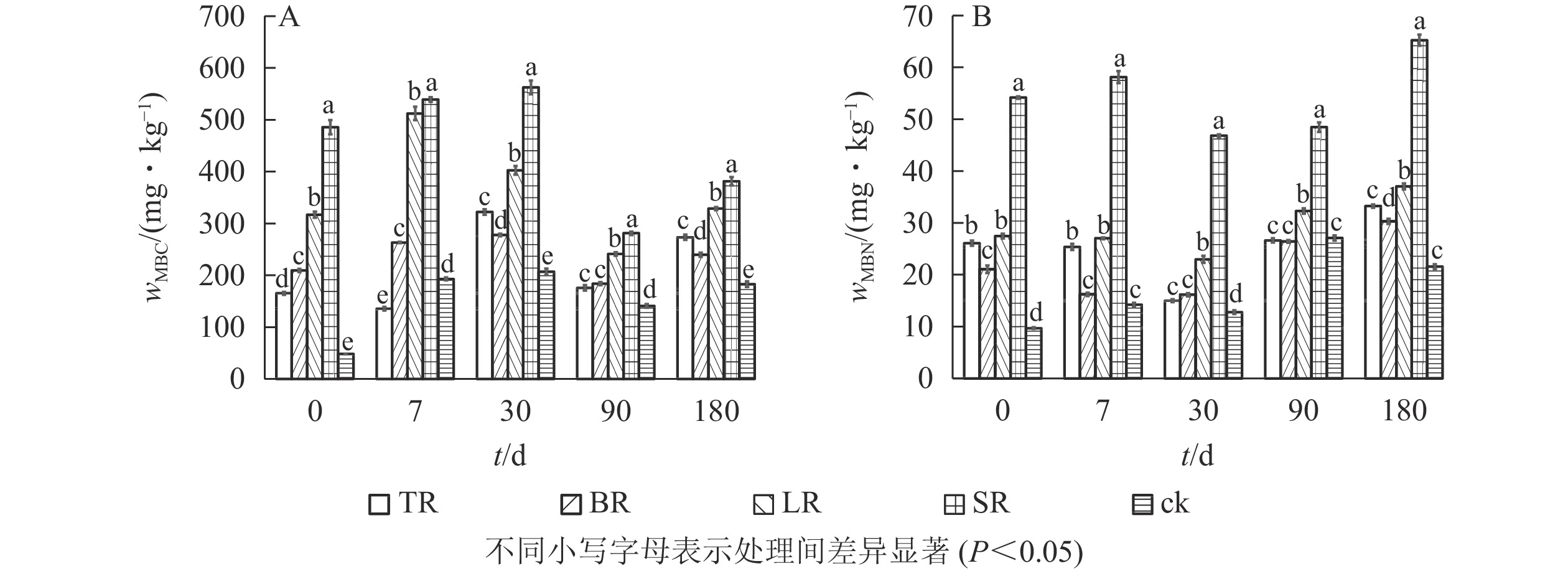-
在资源综合利用和固碳减排的背景下,大量的农林废弃物作为生物质原料正在得到开发利用,国内关于生物质原料的研究以农林废弃物中的秸秆较为成熟,其提高土壤肥力和改善土壤生态环境的效应受到学界广泛认可,在农田土壤中的应用普遍。众多研究表明:秸秆作为生物质原料对土壤微生物的数量和活性具有显著影响[1-4],可有效提高土壤碳氮磷钾等养分含量[5-8]。但也有研究发现:作为营养元素循环及形态转换的重要承担者,土壤微生物在驱动养分周转的同时也会对土壤二氧化碳(CO2)的释放产生影响[9-11]。因此,秸秆施用虽然补充了土壤养分,但也在一定程度上造成CO2排放增加。杨树Populus具有生长快、成材早、产量高、易于更新等特点,是世界中纬度平原地区栽培面积最大、木材产量最高的速生用材树种之一[12]。作为重要的多功能用材和生态公益树种,中国杨树人工林面积居世界首位,杨树人工林的大量采伐和生产利用,使得采伐剩余物利用空间和潜力巨大。目前对林业采伐剩余物利用的研究,仅有少量针对杉木Cunninghamia lanceolata[13-15]、桉树Eucalyptus[16-17]和松树Pinus[18-19]等的报道,针对杨树人工林采伐剩余物利用的研究更是鲜有。本研究以农业剩余物还田后在土壤中发挥的效应为参考,以南方地区重点推广的杨树‘南林895杨’Populus × euramericana‘Nanlin -895’采伐剩余物和水稻Oryza sativa秸秆为研究对象,比较施用杨树不同组分(树枝、树皮、树叶)和水稻秸秆后,森林土壤的生物化学性质差异,旨在探究杨树采伐剩余物对森林土壤养分和CO2释放的综合效应,以期为杨树采伐剩余物还林提供理论依据。
-
2018年10月于江苏省宿迁市泗洪县陈圩林场采集‘南林895杨’采伐剩余物及试验地周围农田水稻。所采原材料按杨树树皮、树枝、树叶、水稻秸秆分类,用去离子水洗净,70 ℃恒温烘干后粉碎过2 mm筛,密封保存备用。生物质原料基本性质见表1。
表 1 供试生物质原料基本性质
Table 1. Basic properties of biomass materials used in this study
生物质原料 pH 全碳/(g·kg−1) 全氮/(g·kg−1) 碳氮比 全磷/(g·kg−1) 全钾/(g·kg−1) 树枝 6.16±0.08 b 481.87±2.72 a 5.53±0.21 c 87.45±3.37 b 0.87±0.01 b 4.65±0.06 c 树皮 5.60±0.08 c 465.50±9.15 b 3.70±0.14 d 126.26±7.51 a 0.30±0.02 d 3.10±0.04 d 树叶 5.49±0.12 c 415.17±4.50 c 14.07±0.26 a 29.46±0.29 c 0.69±0.01 c 6.31±0.45 b 水稻秸秆 6.41±0.07 a 417.77±4.30 c 11.90±0.36 b 35.16±0.83 c 0.97±0.01 a 19.83±0.44 a 说明:同列不同小写字母表示不同生物质原料性质间差异显著(P<0.05) 2019年3月于江苏省宿迁市泗洪县陈圩林场采集‘南林895杨’中龄林(12年生)林地0~20 cm表层土壤,土壤母质为洪泽湖淤积土,土壤质地为黏土。剔除动植物残体及小石子等杂质,过2 mm筛后置于4 ℃冰箱保存备用。土壤基本理化性质如下:土壤容重为(1.42±0.02) g·cm−3;pH为7.18±0.05;阳离子交换量为(31.02±0.66) cmol·kg−1;全碳和全氮质量分数分别为(9.77±0.01)和(1.13±0.01) g·kg−1,碳氮比为9.44±0.25;全磷和全钾质量分数分别为(0.35±0.00)和(9.52±0.75) g·kg−1。
-
试验共设置5个处理:土壤(对照,ck)、土壤+杨树树皮(BR)、土壤+杨树树枝(TR)、土壤+杨树树叶(LR)、土壤+水稻秸秆(SR),每个处理3个重复。室内培养方法参考ZIMMERMAN[20]和闫德智等[21],并依据陈圩林场杨树人工林单位面积凋落物(20 g·kg−1)的实际情况,控制各处理中生物质原料质量分数(2%),混合均匀后装入自制的聚乙烯塑料盒(口径8 cm,高12 cm),采用称量法用无菌水调节土壤含水量至田间持水量的60%,加盖密封后在25 ℃恒温培养箱中暗培养180 d。培养期间,保持土壤含水量为田间持水量的60%。为维持土壤良好的通气条件,1周通气1次,时长20 min。
采取破坏性取样测定土壤生物化学性质,取样时间为培养的0、7、15、30、60、90、120、180 d。基于密闭箱法原理采取放回式取样测定土壤CO2,具体操作步骤为:用30 mL针筒从密闭培养罐上端采集0时刻的15 mL气样,1 h后采集第2针气体15 mL,所取气体均储存于事先抽真空的锡纸气体采样袋中,在3 d内测定。取样后的培养罐重新密封放回恒温培养箱,留待下一次采样。取样时间为培养后的第1、3、5、7、10、13、16、19、22、25、30、35、40、47、54、61、70、79、88、99、110、121、134、149、165、180 天。
-
生物质原料和供试土壤的pH(记为pH1和pH2)利用pH仪测定,其中生物质原料与去离子水的质量体积比为1.0∶20.0,土壤与去离子水质量体积比为1.0∶2.5,参照LY/T 1239−1999《森林土壤pH值的测定》进行。生物质原料和土壤的全碳(TC1和TC2)、全氮(TN1和TN2)及碳氮比(C1/N1和C2/N2)用元素分析仪(Vario MACRO Cube, Elementar, 德国)测定。生物质原料和土壤的全磷(TP1和TP2)和全钾(TK1和TK2)采用浓硫酸-高氯酸消煮法提取,其中全磷采用钼锑抗比色法测定,全钾用原子吸收分光光度计测定,参照LY/T 1232−1999《森林土壤全磷的测定》和LY/T 1234−1999《森林土壤全钾的测定》进行。按1.0∶5.0的质量体积比用2 mol·L−1 氯化钾溶液提取土壤无机氮,其中铵态氮(NH4 +-N)采用靛酚蓝比色法,硝态氮(NO3 −-N)采用紫外分光光度法进行测定,参照鲍士旦[22]和GB/T 32737−2016《土壤硝态氮的测定 紫外分光光度法》进行。用盐酸-硫酸双酸提取,钼锑抗比色法测定土壤有效磷(AP),参照LY/T 1233−1999《森林土壤有效磷的测定》进行。用1 mol·L−1乙酸铵提取,原子吸收分光光度计测定土壤速效钾(AK),参照LY/T 1236−1999《森林土壤速效钾的测定》进行。用1 mol·L−1乙酸铵交换法测定并计算土壤阳离子交换量(CEC),参照LY/T 1243−1999《森林土壤阳离子交换量的测定》进行。土壤微生物生物量碳(MBC)和微生物生物量氮(MBN)采用氯仿熏蒸-K2SO4浸提法提取,其中MBC利用TOC仪测定,MBN利用流动分析仪测定[23-24]。计算MBC=(熏蒸后土壤有机碳-熏蒸前土壤有机碳)/0.45。其中:MBC为土壤微生物生物量碳质量分数(mg·kg−1),0.45为熏蒸提取法提取液的有机碳增量换算成土壤微生物生物量碳的换算系数。计算MBN=(熏蒸后微生物量氮−熏蒸前土壤微生物量氮)/0.25。其中:MBN为微生物生物量氮质量分数(mg·kg−1),0.25为微生物体氮的矿化系数,即矿化得到的微生物体氮是微生物体总氮的0.25倍。
-
采用气相色谱仪(Agilent 7890A, 美国)测定CO2气体质量分数(mg·kg−1)。载气为5%的氩甲烷,流速为40 mL·min−1,色谱柱和ECD检测器的温度设置为40和300 ℃,炉温和FID检测器的温度设置为40和200 ℃。计算CO2日释放速率:
$F = 24\dfrac{{\rho \dfrac{{\Delta c}}{{\Delta t}}V\dfrac{{273}}{{273 + T}}}}{W} $ 。其中:F为气体日释放速率(mg·kg−1·d−1);ρ为标准状态下气体的质量浓度(g·L−1);∆c为培养瓶内CO2气体质量分数变化量(mg·kg−1),∆t为单位时间(h),∆c/∆t表示单位时间内培养瓶内CO2气体质量分数变化量(mg·kg−1·h−1);V为培养瓶中气体的有效空间体积(L);W是培养瓶内样品的质量(kg);T为培养温度(℃)。温室气体累积排放量:$S = \displaystyle \sum\limits_{i = 1}^n {\dfrac{{{F_{\left( {i + 1} \right)}} + {F_i}}}{2}} \left[ {{t_{\left( {i + 1} \right)}} - {t_i}} \right] $ ,n=180。其中:s为气体的累积排放量(mg·kg−1);Fi为培养第i天的气体日释放速率;ti为采样时的培养天数(d)[25]。 -
数据统计分析使用Excel 2010和SPSS 20.0,多重比较采用最小显著差异法(LSD,α=0.05),图表绘制使用Excel 2010和Origin 2018。数据为平均值±标准误。
-
土壤中添加不同生物质原料显著影响土壤微生物生物量(图1,P<0.05)。由图1A可知:在培养的各阶段,SR的土壤MBC质量分数始终高于其他处理(P<0.05),与对照相比,各处理组土壤MBC质量分数均显著升高(P<0.05)。培养结束时,各处理的土壤MBC质量分数分别比对照增加了50.00%、31.00%、80.00%和109.00%,说明添加4种生物质原料均能提高土壤MBC质量分数。

图 1 生物质原料施用对土壤微生物生物量的影响
Figure 1. Effects of biomass material additions on soil microbial biomass in the soil
由图1B可知:与对照相比,培养结束后各处理组土壤MBN显著增加(P<0.05),其中SR的土壤MBN质量分数显著高于其他处理,各处理的土壤MBN质量分数分别比对照增加了54.00%、40.00%、72.00%和203.00%,说明4种生物质原料的施用均能增加土壤MBN质量分数。
相关性分析表明(表2):施用生物质原料180 d后,土壤MBC与TN1、TP1、TK1存在极显著正相关(P<0.01),与TC1和C1/N1存在极显著负相关(P<0.01);土壤MBN与TC1、C1/N1存在显著负相关(P<0.05),与TK1存在极显著正相关(P<0.01)。
表 2 生物质原料性质与土壤各指标间的相关性
Table 2. Correlations between properties of biomass materials and properties of soil
土壤指标 生物质原料性质 TC1 TN1 C1/N1 TP1 TK1 MBC −0.822** 0.846** −0.903** 0.732** 0.889** MBN −0.629* 0.556 −0.637* 0.655* 0.998** NH4 +-N 0.777** −0.904** 0.825** −0.273 −0.181 NO3 −-N −0.826** 0.733** −0.752** 0.541 0.938** AP −0.225 0.564 −0.692* 0.812** 0.194 AK −0.584* 0.532 −0.632* 0.709** 0.990** CO2日释放速率 0.851** −0.914** 0.927** −0.610* −0.658* 说明:*表示显著相关(P<0.05),**表示极显著相关(P<0.01) -
不同生物质原料对土壤速效养分的影响动态相似,但不同养分间存在差异(图2)。培养初期,SR土壤NH4 +-N质量分数下降最显著;培养中后期,不同处理的NH4 +-N质量分数均呈先上升后下降的趋势;培养结束时,不同处理的土壤NH4 +-N质量分数均明显减少,从大到小依次为BR、TR、对照、SR、LR(图2A)。除对照的土壤NO3 −-N质量分数随培养时间增加始终呈上升趋势,其他处理土壤NO3 −-N质量分数均表现为培养初期显著下降,培养60 d时降到最低,培养结束时略有增加,从大到小依次为对照、SR、LR、BR、TR(图2B)。

图 2 生物质原料施用对土壤速效养分的影响
Figure 2. Effects of biomass material additions on available nutrients in the soil
由图2C可知:土壤有效磷质量分数表现为培养初期下降明显,初期至中后期上下波动,中后期有所上升。培养结束后,TR、BR、LR和SR的土壤有效磷质量分数分别比对照增加了202.00%、4.73%、192.00%和143.00%。图2D表明:整个培养过程中,速效钾质量分数波动幅度相对较小,各处理组的土壤速效钾质量分数均高于对照。SR的土壤速效钾质量分数始终显著高于其他处理(P<0.05),培养结束时,各土壤的速效钾质量分数从大到小依次为SR、LR、TR、BR、对照。
结合表2可知:土壤NH4 +-N与TC1和C1/N1呈极显著正相关 (P<0.01),与TN1呈极显著负相关(P<0.01);土壤NO3 −-N与TN1呈极显著正相关(P<0.01),与TC1和C1/N1呈极显著负相关(P<0.01)。同时,土壤AP、AK分别与TP1、TK1存在极显著正相关(P<0.01)。说明生物质原料的施用对土壤无机氮、有效磷和速效钾的变化有直接影响。由表3可知:培养期间(0、7、30、90和180 d),土壤性状间存在一定的相关性,其中,土壤AP、AK均分别与土壤MBC、MBN和NH4 +-N存在极显著正相关(P<0.01)。
表 3 施用生物质原料土壤各指标的相关性
Table 3. Correlations between properties of soil with biomass material additions
土壤指标 MBC MBN NH4 +-N NO3 −-N AP AK MBN 0.630** NH4 +-N 0.364** 0.203 NO3 −-N −0.243* −0.152 0.265* AP 0.400** 0.377** 0.577** −0.120 AK 0.737** 0.867** 0.412** −0.204 0.419** CO2日释放速率 0.504** 0.284* 0.267* −0.256* 0.680** 0.318** 说明:*表示显著相关(P<0.05),**表示极显著相关(P<0.01) -
土壤添加不同生物质原料后土壤CO2日释放速率的变化趋势基本相同(图3),培养第1 天出现峰值,随培养时间增加逐渐下降。培养30 d后TR、BR和对照的土壤CO2日释放速率逐渐趋于稳定。培养的前47 d内,SR、LR的土壤CO2日释放速率较高,培养61 d后趋于稳定(图3A)。

图 3 不同处理下土壤CO2日释放速率(A)和累积释放量(B)
Figure 3. Effects of biomass material additions on CO2 daily emission rate (A) and cumulative emission (B) in the soil during the incubation period
从图3B看,培养结束(180 d)时,不同处理的土壤CO2累积释放量从大到小依次为SR、LR、TR、BR、对照。与对照相比,TR、BR、LR、SR的土壤CO2累积释放量分别提高了38.92%、36.43%、209.88%和291.36%。
土壤CO2日释放速率与TC1和C1/N1呈极显著正相关(P<0.01),与TN1呈极显著负相关(P<0.01,表2),与土壤MBC、AP、AK呈极显著正相关(P<0.01,表3),说明土壤呼吸与生物质原料的碳氮质量分数及微生物活动密切联系,且受土壤有效养分的调控。
-
土壤微生物的数量和活性直接或间接地反映了土壤有效养分的供给能力。一方面,土壤微生物是养分循环的重要因子,生物质原料进入土壤后,土壤中的氮磷钾等元素可能以各种形态存在,其有效性受微生物矿化-固持作用的控制。研究认为:有机物料的碳氮比是影响其还田后土壤氮素矿化固持的重要因子之一[26-27],土壤微生物活动是氮素循环的重要驱动力,但有机物料适宜的碳氮比才有利于微生物的活动[28-29]。KUMAR等[30]认为碳氮比为25是氮素转化的关键值,低于25的碳氮比有利于微生物吸收利用氮素,高于25则相反。本研究发现:在培养初期,施用生物质原料的土壤无机氮质量分数均明显下降,同时土壤微生物生物量碳氮均显著增加。这是因为随着生物质的施入,土壤养分供给充足,促进了微生物活性;但由于4种添加物的碳氮比均较高,微生物为了维持生长代谢的碳氮平衡,需要吸收土壤中的无机氮,即土壤无机氮被微生物固持,土壤无机氮质量分数降低,与闫德智等[21]和李涛等[31]的结果一致。至培养中后期,随着碳源的消耗,微生物活动减缓,当土壤碳氮比下降到一定程度后,微生物矿化释放无机态氮素,土壤无机氮质量分数略有回升。另一方面,土壤微生物本身是土壤碳氮能源库,土壤微生物量碳氮的增减揭示了碳氮进入土壤后生物固持和释放的本质。张静等[32]研究表明:当玉米Zea mays秸秆还田量为9 000 kg·hm−2时,麦地的微生物生物量碳显著提高,为下一茬作物储备了丰富的碳源。本研究发现:与对照相比,杨树材料的施用明显增加了土壤微生物生物量碳氮;同时,相关性分析可知:土壤MBC、MBN与生物质原料具有显著相关关系,说明杨树采伐剩余物可以作为生物质原料来提高土壤的碳氮储备量。添加生物质后,土壤有效磷的变化趋势与无机氮相似,均为先降低后逐渐趋于稳定,推测可能与磷的生物固持有关[33-36]。对于森林土壤来说,碳磷比是影响磷矿化的关键,本研究处理初期,磷及碳磷比较高,微生物吸收固定土壤中的有效磷,培养后期,磷的矿化作用开始增强,有效磷质量分数有所上升,与SAGGER等[37]和DIETER等[38]的观点一致。
本研究中各处理土壤的速效钾质量分数与土壤微生物生物量质量分数具有对应关系,但整体变化幅度较小,原因可能是土壤自身速效钾质量分数较高,固钾能力较弱或固钾需求已经满足。黄帅等[39]的研究也证明土壤固钾率与速效钾质量分数和钾离子饱和度均呈极显著负相关。本研究为土壤空白试验,不存在植物对土壤速效钾的吸收利用,不需要消耗大量交换性钾,因此在微生物代谢周转过程中,矿化产生速效钾的质量分数也相对较少。
就提升土壤铵态氮和有效磷质量分数而言,施用杨树树皮和树枝的效果优于秸秆和对照;对于提高硝态氮质量分数,虽然3种杨树材料的施用效果较秸秆差,但树叶和树皮的施用效果优于树枝;从速效钾质量分数来看,杨树材料的施用效果均明显优于对照。因此,施用杨树采伐剩余物对土壤中氮素的转化具有积极影响,在无机氮质量分数较高的土壤中,施用碳氮比较高的树皮和树枝原料有利于微生物对土壤氮素的固定,虽然降低了氮素有效性,但一定程度上避免了氮素的流失;当土壤无机氮质量分数较低时,选择碳氮比较低的树叶原料,微生物能更快地矿化释放无机氮供植物利用。本研究还发现:施用杨树采伐剩余物也具有提高土壤有效磷和速效钾质量分数的潜力,不同杨树材料中以树枝和树叶的施用效果更好。
-
土壤有机碳的矿化受微生物活动的密切影响,研究[40]表明:土壤呼吸释放的CO2约50%~70%来自微生物对有机质的分解。秸秆还田试验[41-42]表明:土壤呼吸与土壤微生物量碳存在显著正相关关系。本研究中,不同处理土壤CO2日释放速率均表现为初期较快、中期逐渐减缓、培养后期趋于稳定的趋势,该动态规律与朱文玲[43]的研究结果一致,并与本研究中土壤微生物生物量碳氮的变化趋势相对应。
目前关于有机物料还田是否能减少CO2的排放还存在一定争议。众多研究[11,44-45]认为:生物质原料的添加提供了更多土壤呼吸和CO2释放所需的碳素,使CO2排放量增加,存在负面的环境效应。本研究也发现:添加4种生物质材料后,土壤CO2日释放速率和累积释放量均高于对照。从土壤CO2日释放速率来看,秸秆和树叶施入后,土壤矿化速率高于树枝和树皮原料。从累积释放量来看,虽然培养初期添加树叶使土壤有机碳的矿化量更大,但长期培养过程中添加秸秆对有机碳的矿化效果更明显,即4种材料的施用都会给环境带来的一定程度的负面影响,但相比秸秆,添加杨树采伐剩余物后土壤CO2排放量明显要低。也有研究[46-47]证实,有机物料的施用能减少碳排放,这可能与施用方式、施用量及生物质原料和土壤性质不同有关。
本研究以目前在农田土壤中广泛应用的秸秆原料为参照,证明了杨树采伐剩余物既能满足土壤有效养分的补充,又能相对控制CO2排放,具有作为生物质原料还林的巨大潜力。基于中国气候条件、土壤类型和植被种类,有必要对杨树采伐剩余物的施用量和施用方式进行长期田间综合试验和评价,探究其在土壤中施用的现实意义。同时,除监测CO2释放外,还有必要在施用过程中进一步测定甲烷(CH4)和氧化亚氮(N2O) 等重要温室气体,以明确杨树采伐剩余物施用的生态环境效应,真正实现林业的绿色可持续发展。
Impacts of poplar harvesting residue additions on soil nutrients and CO2 emission
-
摘要:
目的 探索施用杨树Populus采伐剩余物对土壤养分和二氧化碳(CO2)释放的影响,为其潜在利用提供参考。 方法 以杨树树枝、树皮、树叶和水稻Oryza sativa秸秆等4种农林废弃物为生物质原料,根据杨树人工林单位面积凋落物量,以2%质量分数(以烘干土质量计)均匀混入新鲜土壤,25 ℃恒温培养箱中暗培养180 d。控制培养期间土壤含水量为田间持水量的60%。测定不同处理下土壤微生物生物量碳(MBC)、微生物生物量氮(MBN)、无机氮[铵态氮(NH4 +-N)和硝态氮(NO3 −-N)]、有效磷(AP)、速效钾(AK)等质量分数以及CO2日释放速率和累积释放量。 结果 ① 4种生物质原料施用显著影响土壤微生物生物量及土壤氮磷钾的有效性(P<0.05)。相比对照,杨树树枝、树皮、树叶和水稻秸秆处理的土壤MBC质量分数分别增加了50%、31%、80%和109%,土壤MBN质量分数分别增加了54%、40%、72%和203%。施用杨树树皮和树枝土壤的NH4 +-N质量分数从大到小依次为对照、秸秆处理、树叶处理、树皮处理、树枝处理。土壤AP质量分数以树枝处理最高,AK质量分数以秸秆处理最高。②不同处理的土壤CO2日释放速率均表现为初期较快,中期逐渐减缓,后期趋于稳定。培养期间,秸秆处理的土壤CO2累积释放量最高,显著高于其他处理(P<0.05),其次为杨树树叶,不同处理间差异显著(P<0.05)。③相关性分析表明:生物质原料的性质与土壤微生物生物量、土壤养分和CO2释放量存在显著相关性。其中土壤微生物生物量与生物质原料的全氮、全磷、全钾显著正相关(P<0.05),与全碳和碳氮比显著负相关(P<0.05);土壤CO2日释放速率与土壤MBC、MBN、NH4 +-N、AP和AK均显著正相关(P<0.05),但与NO3 −-N呈极显著负相关(P<0.01)。 结论 从土壤养分和环境效应综合考量,杨树采伐剩余物的施用能提高土壤有效态的氮磷钾等养分,相对减少碳排放。图3表3参47 Abstract:Objective Impacts of the addition of poplar harvesting residues on soil nutrients and CO2 emission were investigated in controlled conditions to provide a reference for its potential utilization. Method The indoor incubation experiment was carried out by selecting logging residues of twigs, barks, and leaves from a poplar plantation and the rice straw as research materials. Based on the litter amount in the unit area of the poplar plantation, the fresh soil equivalent to 100 g of dry soil weight and biomass materials equivalent to 2% of dry soil weight were mixed evenly. Then the mixed soils were loaded into a homemade polyethylene plastic box, and incubated in a constant temperature incubator at 25℃ for 180 days in darkness. During the culture period, the soil moisture content was controlled to 60% of the field moisture capacity. Dynamic variations in microbial biomass carbon (MBC) and nitrogen (MBN), inorganic nitrogen (NH4 +-N and NO3 −-N), available phosphorus (AP) and available potassium (AK) as well as CO2 in the soil were measured. Result (1) The addition of all four residue biomass significantly affected microbial biomass and nutrient availability in the soil (P<0.05). Compared with the control, the soil MBC contents treated by the residue biomass of poplar twigs, barks, leaves and straw increased by 50%, 31%, 80% and 109% respectively, while the soil MBN contents increased by 54%, 40%, 72% and 203%, respectively. The contents of NH4 +-N in the soil treated with bark and twigs residues were higher than those in the control and rice straw treatments, whereas the NO3 −-N content in the soil was in the order of control>rice straw>leaf residue>bark residue>twig residue treatments. The highest AP content was observed in the soil treated with twigs, while the AK content in the soil treated with rice straw was higher than that treated with other biomass residues. (2) After adding biomass residues into the soil, the daily release rate of CO2 from the soil showed a tendency with being relatively fast in the initial period, gradually slowing down in the middle stage, and tending to be stable in the later stage of the incubation. After 180 days of indoor incubation, the cumulative CO2 emission from the soil treated with rice straw was significantly higher than that of the other treatments (P<0.05), followed by the soil treated with poplar leaves. (3) Correlation analysis showed that microbial biomass, nutrient contents and CO2 daily release rate in the soil were obviously correlated to the properties of biomass residues. Of them, a significantly positive correlation of soil microbial biomass to the contents of total nitrogen, total phosphorus and total potassium but a significantly negative correlation to the total carbon content and C/N ratio in the biomass residues were detected (P<0.05). Meanwhile, the CO2 daily emission rate was positively correlated to the contents of MBC, MBN, NH4 +-N, AP and AK in the soil (P<0.05), whereas a significantly negative correlation of the CO2 daily emission rate to the contents of NO3 −-N was observed (P<0.01). Conclusion From the views of soil nutrients and environmental effects, application of poplar harvesting residues not only can increase the contents of soil available nutrients, but also relatively reduce carbon emissions compared with the rice straw. [Ch, 3 fig. 3 tab. 47 ref.] -
Key words:
- soil ecology /
- poplar /
- harvesting residues /
- microbial biomass /
- nutrient availability /
- greenhouse gas
-
表 1 供试生物质原料基本性质
Table 1. Basic properties of biomass materials used in this study
生物质原料 pH 全碳/(g·kg−1) 全氮/(g·kg−1) 碳氮比 全磷/(g·kg−1) 全钾/(g·kg−1) 树枝 6.16±0.08 b 481.87±2.72 a 5.53±0.21 c 87.45±3.37 b 0.87±0.01 b 4.65±0.06 c 树皮 5.60±0.08 c 465.50±9.15 b 3.70±0.14 d 126.26±7.51 a 0.30±0.02 d 3.10±0.04 d 树叶 5.49±0.12 c 415.17±4.50 c 14.07±0.26 a 29.46±0.29 c 0.69±0.01 c 6.31±0.45 b 水稻秸秆 6.41±0.07 a 417.77±4.30 c 11.90±0.36 b 35.16±0.83 c 0.97±0.01 a 19.83±0.44 a 说明:同列不同小写字母表示不同生物质原料性质间差异显著(P<0.05) 表 2 生物质原料性质与土壤各指标间的相关性
Table 2. Correlations between properties of biomass materials and properties of soil
土壤指标 生物质原料性质 TC1 TN1 C1/N1 TP1 TK1 MBC −0.822** 0.846** −0.903** 0.732** 0.889** MBN −0.629* 0.556 −0.637* 0.655* 0.998** NH4 +-N 0.777** −0.904** 0.825** −0.273 −0.181 NO3 −-N −0.826** 0.733** −0.752** 0.541 0.938** AP −0.225 0.564 −0.692* 0.812** 0.194 AK −0.584* 0.532 −0.632* 0.709** 0.990** CO2日释放速率 0.851** −0.914** 0.927** −0.610* −0.658* 说明:*表示显著相关(P<0.05),**表示极显著相关(P<0.01) 表 3 施用生物质原料土壤各指标的相关性
Table 3. Correlations between properties of soil with biomass material additions
土壤指标 MBC MBN NH4 +-N NO3 −-N AP AK MBN 0.630** NH4 +-N 0.364** 0.203 NO3 −-N −0.243* −0.152 0.265* AP 0.400** 0.377** 0.577** −0.120 AK 0.737** 0.867** 0.412** −0.204 0.419** CO2日释放速率 0.504** 0.284* 0.267* −0.256* 0.680** 0.318** 说明:*表示显著相关(P<0.05),**表示极显著相关(P<0.01) -
[1] 蔡立群, 牛怡, 罗珠珠, 等. 秸秆促腐还田土壤养分及微生物量的动态变化[J]. 中国生态农业学报, 2014, 22(9): 1047 − 1056. CAI Liqun, NIU Yi, LUO Zhuzhu, et al. Dynamic characteristics of soil nutrients and soil microbial biomass of field-returned straws at different decay accretion conditions [J]. Chin J Eco-Agric, 2014, 22(9): 1047 − 1056. [2] 王宁, 罗佳琳, 赵亚慧, 等. 不同麦秸还田模式对稻田土壤微生物活性和微生物群落组成的影响[J]. 农业环境科学学报, 2020, 39(1): 125 − 133. WANG Ning, LUO Jialin, ZHAO Yahui, et al. Effects of different models of wheat straw return on paddy soil microbial activities and community compositions [J]. J Agro-Environ Sci, 2020, 39(1): 125 − 133. [3] 陈安强, 付斌, 鲁耀, 等. 有机物料输入稻田提高土壤微生物碳氮及可溶性有机碳氮[J]. 农业工程学报, 2015, 31(21): 160 − 167. CHEN Anqiang, FU Bin, LU Yao, et al. Exogenous organic materials applied to paddy field improving soil microbial biomass C, N and dissolved organic C, N [J]. Trans Chin Soc Agric Eng, 2015, 31(21): 160 − 167. [4] CHEN Lin, ZHANG Jiabao, ZHAO Bingzi, et al. Effects of straw amendment and moisture on microbial communities in Chinese fluvo-aquic soil [J]. J Soils Sediments, 2014, 14(11): 1829 − 1840. [5] WANG Weiqi, LAI D Y F, WANG Chongqing, et al. Effects of rice straw incorporation on active soil organic carbon pools in a subtropical paddy field [J]. Soil Tillage Res, 2015, 152: 8 − 16. [6] 郭成藏, 李鲁华, 黄金花, 等. 秸秆还田对长期连作棉田土壤微生物量碳氮磷的影响[J]. 农业资源与环境学报, 2015, 32(3): 296 − 304. GUO Chengzang, LI Luhua, HUANG Jinhua, et al. Effects of cotton straw incorporation on soil microbial biomass carbon, nitrogen and phosphorus in long-term continuous cropping cotton field [J]. J Agric Resour Environ, 2015, 32(3): 296 − 304. [7] 张宏威, 康凌云, 梁斌, 等. 长期大量施肥增加设施菜田土壤可溶性有机氮淋溶风险[J]. 农业工程学报, 2013, 29(21): 99 − 107. ZHANG Hongwei, KANG Lingyun, LIANG Bin, et al. Long-term heavy fertilization increases leaching risk of soil soluble organic nitrogen in vegetable greenhouse [J]. Trans Chin Soc Agric Eng, 2013, 29(21): 99 − 107. [8] 吕盛, 王子芳, 高明, 等. 秸秆不同还田方式对紫色土微生物量碳、氮、磷及可溶性有机质的影响[J]. 水土保持学报, 2017, 31(5): 266 − 272. LÜ Sheng, WANG Zifang, GAO Ming, et al. Effects of different straw returning methods on soil microbial biomass carbon, nitrogen, phosphorus and soluble organic matter in purple soil [J]. J Soil Water Conserv, 2017, 31(5): 266 − 272. [9] 臧逸飞, 郝明德, 张丽琼, 等. 26年长期施肥对土壤微生物量碳、氮及土壤呼吸的影响[J]. 生态学报, 2015, 35(5): 1445 − 1451. ZANG Yifei, HAO Mingde, ZHANG Liqiong, et al. Effects of wheat cultivation and fertilization on soil microbial biomass carbon, soil microbial biomass nitrogen and soil basal respiration in 26 years [J]. Acta Ecol Sin, 2015, 35(5): 1445 − 1451. [10] 李晓莎, 武宁, 刘玲, 等. 不同秸秆还田和耕作方式对夏玉米农田土壤呼吸及微生物活性的影响[J]. 应用生态学报, 2015, 26(6): 1765 − 1771. LI Xiaosha, WU Ning, LIU Ling, et al. Effects of different straw recycling and tillage methods on soil respiration and microbial activity [J]. Chin J Appl Ecol, 2015, 26(6): 1765 − 1771. [11] 丁瑞霞, 王维钰, 张青. 两种轮作模式下秸秆还田对土壤呼吸及其温度敏感性的影响[J]. 中国生态农业学报, 2017, 25(8): 1106 − 1118. DING Ruixia, WANG Weiyu, ZHANG Qing. Effect of straw mulching on soil respiration and its' temperature sensitivity under different crop rotation systems [J]. Chin J Eco-Agric, 2017, 25(8): 1106 − 1118. [12] 方升佐. 中国杨树人工林培育技术研究进展[J]. 应用生态学报, 2008, 19(10): 2308 − 2316. FANG Shengzuo. Silviculture of poplar plantation in China: a review [J]. Chin J Appl Ecol, 2008, 19(10): 2308 − 2316. [13] 贾淑娴, 吴传敬, 刘小飞, 等. 采伐剩余物的处理方式对杉木幼林土壤磷组分及其有效性的影响[J]. 应用生态学报, 2019, 30(11): 3662 − 3670. JIA Shuxian, WU Chuanjing, LIU Xiaofei, et al. Effects of harvest residue treatments on soil phosphorus fractions and availability in a young Chinese fir plantation [J]. Chin J Appl Ecol, 2019, 30(11): 3662 − 3670. [14] 吴传敬, 郭剑芬, 许恩兰, 等. 采伐残余物不同处理方式对杉木幼林土壤有机碳组分和相关酶活性的影响[J]. 土壤学报, 2019, 56(6): 1504 − 1513. WU Chuanjing, GUO Jianfen, XU Enlan, et al. Effects of logging residue on composition of soil carbon and activity of related enzymes in soil of a young Chinese fir plantation as affected by residue handling mode [J]. Acta Pedol Sin, 2019, 56(6): 1504 − 1513. [15] 王伟峰, 魏晓华, 段玉玺, 等. 采伐剩余物处理方式对杉木人工林固碳量的长期影响[J]. 水土保持研究, 2016, 23(6): 198 − 203. WANG Weifeng, WEI Xiaohua, DUAN Yuxi, et al. Long-term effects of logging residue treatment on carbon sequestration in Chinese fir plantation [J]. Res Soil Water Conserv, 2016, 23(6): 198 − 203. [16] 翁怡琳. 桉树人工林采伐剩余物分解与养分释放特征[D]. 长沙: 中南林业科技大学, 2019. WENG Yilin. Decomposition and Nutrient Release Characteristics of Harvest Residues in Eucalyptus Plantation[D]. Changsha: Central South University of Forestry and Technology, 2019. [17] 于洋洋, 程飞, 廖博一, 等. 林地清理方式对桉树人工林生长的影响[J]. 福建农林大学学报(自然科学版), 2019, 48(1): 41 − 47. YU Yangyang, CHENG Fei, LIAO Boyi, et al. Effects of ground clearance on the growth of Eucalyptus plantation [J]. J Fujian Agric For Univ Nat Sci Ed, 2019, 48(1): 41 − 47. [18] 孙启越, 姚丹阳, 李秀丽, 等. 基于正交试验的华北落叶松采伐剩余物处理方式优选[J]. 福建农林大学学报(自然科学版), 2019, 48(5): 633 − 639. SUN Qiyue, YAO Danyang, LI Xiuli, et al. Optimizing the process of logging residue of Larix principis-rupprechtii based on orthogonal experiment [J]. J Fujian Agric For Univ Nat Sci Ed, 2019, 48(5): 633 − 639. [19] 李华, 郑路, 李朝英, 等. 马尾松人工林采伐剩余物生物量及养分贮量[J]. 生态学杂志, 2018, 37(3): 854 − 860. LI Hua, ZHENG Lu, LI Zhaoying, et al. Biomass and nutrient storage of logging residues of Pinus massoniana plantation [J]. Chin J Ecol, 2018, 37(3): 854 − 860. [20] ZIMMERMAN A R. Abiotic and microbial oxidation of laboratory-produced black carbon (biochar) [J]. Environ Sci Technol, 2010, 44(4): 1295 − 1301. [21] 闫德智, 王德建. 添加秸秆对土壤矿质氮量、微生物氮量和氮总矿化速率的影响[J]. 土壤通报, 2012, 43(3): 631 − 636. YAN Dezhi, WANG Dejian. Nitrogen mineralization of 15N labeled straw added into the paddy soils in Taihu region [J]. Chin J Soil Sci, 2012, 43(3): 631 − 636. [22] 鲍士旦. 土壤农化分析[M]. 3版. 北京: 中国农业出版社, 2000. [23] VANCE E D, BROOKES P C, JENKINSON D S. An extraction method for measuring soil microbial biomass C [J]. Soil Biol Biochem, 1987, 19(6): 703 − 707. [24] 吴金水, 林启美, 黄巧云, 等. 土壤微生物生物量测定方法及应用[M]. 北京: 气象出版社, 2006. [25] 雷海迪. 杉木凋落物及其生物炭对土壤CO2排放、微生物和酶活性的影响[D]. 福州: 福建师范大学, 2016. LEI Haidi. Effect of Chinese Fir Litter and Its Biochar on Soil CO2 Emission, Microbe and Enzyme Activity [D]. Fuzhou: Fujian Normal University, 2016. [26] 黄文昭, 赵秀兰, 朱建国, 等. 土壤碳库激发效应研究[J]. 土壤通报, 2007, 38(1): 149 − 154. HUANG Wenzhao, ZHAO Xiulan, ZHU Jianguo, et al. Priming effect of soil carbon pools [J]. Chin J Soil Sci, 2007, 38(1): 149 − 154. [27] SAID-PULLICINO D, CUCU M A, SODANO M, et al. Nitrogen immobilization in paddy soils as affected by redox conditions and rice straw incorporation [J]. Geoderma, 2014, 228/229: 44 − 53. [28] 潘剑玲, 代万安, 尚占环, 等. 秸秆还田对土壤有机质和氮素有效性影响及机制研究进展[J]. 中国生态农业学报, 2013, 21(5): 526 − 535. PAN Jianling, DAI Wan’an, SHANG Zhanhuan, et al. Review of research progress on the influence and mechanism of field straw residue incorporation on soil organic matter and nitrogen availability [J]. Chin J Eco-Agric, 2013, 21(5): 526 − 535. [29] HODGE A, ROBINSON D, FITTER A. Are microorganisms moreeffective than plants at competing for nitrogen? [J]. Trends Plant Sci, 2000, 5(7): 304 − 308. [30] KUMAR K, GOH K M. Nitrogen release from crop residues and organic amendments as affected by biochemical composition [J]. Commun Soil Sci Plant Anal, 2003, 34(17/18): 2441 − 2460. [31] 李涛, 何春娥, 葛晓颖, 等. 秸秆还田施氮调节碳氮比对土壤无机氮、酶活性及作物产量的影响[J]. 中国生态农业学报, 2016, 24(12): 1633 − 1642. LI Tao, HE Chun’e, GE Xiaoying, et al. Responses of soil mineral N contents, enzyme activities and crop yield to different C/N ratio mediated by straw retention and N fertilization [J]. Chin J Eco-Agric, 2016, 24(12): 1633 − 1642. [32] 张静, 温晓霞, 廖允成, 等. 不同玉米秸秆还田量对土壤肥力及冬小麦产量的影响[J]. 植物营养与肥料学报, 2010, 16(3): 612 − 619. ZHANG Jing, WEN Xiaoxia, LIAO Yuncheng, et al. Effects of different amount of maize straw returning on soil fertility and yield of winter wheat [J]. Plant Nutr Fert Sci, 2010, 16(3): 612 − 619. [33] TURNER B L, LAMBERS H, CONDRON L M, et al. Soil microbial biomass and the fate of phosphorus during long-term ecosystem development [J]. Plant Soil, 2013, 367(1): 225 − 234. [34] ACHAT D L, MOREL C, BAKKER M R, et al. Assessing turnover of microbial biomass phosphorus: combination of an isotopic dilution method with a mass balance model [J]. Soil Biol Biochem, 2010, 42(12): 2231 − 2240. [35] BÜNEMANN E K, OBERSON A, LIEBISCH F, et al. Rapid microbial phosphorus immobilization dominates gross phosphorus fluxes in a grassland soil with low inorganic phosphorus availability [J]. Soil Biol Biochem, 2012, 51: 84 − 95. [36] KABBA B S, AULAKH M S. Climatic conditions and crop-residue quality differentially affect N, P, and S mineralization in soils with contrasting P status [J]. J Plant Nutr Soil Sci, 2004, 167(5): 596 − 601. [37] SAGGAR S, PARFIT R L, SALT G, et al. Carbon and phosphorus transformations during decomposition of pine forest floor with different phosphorus status [J]. Biol Fert Soils, 1998, 27: 197 − 204. [38] DIETER D, ELSENBEER H, TURNER B L. Phosphorus fractionation in lowland tropical rainforest soils in central Panama [J]. Catena, 2010, 82(2): 118 − 125. [39] 黄帅, 陈佛文, 李继福, 等. 长期施用钾肥对水旱轮作土壤供钾特性的影响[J]. 长江大学学报(自科版), 2018, 15(14): 1 − 5. HUANG Shuai, CHEN Fowen, LI Jifu, et al. Effects of long-term K-fertilizer application on the K supplying capacity in a paddy-upland rotation system [J]. J Yangtze Univ Nat Sci Ed, 2018, 15(14): 1 − 5. [40] RAICH J W, SCHLESINGER W H. The global carbon dioxide flux in soil respiration and its relationship to vegetation and climate [J]. Tellus Series B Chem Phys Meteorol, 1992, 44(2): 81 − 99. [41] 何甜甜, 王静, 符云鹏, 等. 等碳量添加秸秆和生物炭对土壤呼吸及微生物生物量碳氮的影响[J]. 环境科学, 2021, 42(1): 450 − 458. HE Tiantian, WANG Jing, FU Yunpeng, et al. Effects of adding straw and biochar with equal carbon content on soil respiration and microbial biomass carbon and nitrogen [J]. Environ Sci, 2021, 42(1): 450 − 458. [42] 王梦雅, 符云鹏, 黄婷婷, 等. 等碳量添加不同有机物料对土壤有机碳组分及土壤呼吸的影响[J]. 中国烟草学报, 2018, 24(2): 65 − 73. WANG Mengya, FU Yunpeng, HUANG Tingting, et al. Effects of organic material application on organic carbon in and respiration of soil [J]. Acta Tabacaria Sin, 2018, 24(2): 65 − 73. [43] 朱文玲. 小麦与豆科秸秆组合还田对土壤有机碳固持的影响[D]. 杨凌: 西北农林科技大学, 2018. ZHU Wenling. Effect of Combined Amendment of Wheat and Huai Bean Straws on Soil Organic Carbon Sequestration[J]. Yangling: Northwest A&F University, 2018. [44] 陈静, 张建国, 赵英, 等. 秸秆和生物炭添加对关中地区玉米-小麦轮作农田温室气体排放的影响[J]. 水土保持研究, 2018, 25(5): 170 − 178. CHEN Jing, ZHANG Jianguo, ZHAO Ying, et al. Effects of straw and biochar amendment on greenhouse gases emission in wheat-maize rotation cropland [J]. Res Soil Water Conserv, 2018, 25(5): 170 − 178. [45] 李新华, 朱振林, 董红云, 等. 秸秆不同还田模式对玉米田温室气体排放和碳固定的影响[J]. 农业环境科学学报, 2015, 34(11): 2228 − 2235. LI Xinhua, ZHU Zhenlin, DONG Hongyun, et al. Effects of different return modes of wheat straws on greenhouse gas emissions and carbon sequestration of maize fields [J]. J Agro-Environ Sci, 2015, 34(11): 2228 − 2235. [46] NASER H M, NAGATA O, TAMURA S, et al. Methane emissions from five paddy fields with different amounts of rice straw application in central Hokkaido, Japan [J]. Soil Sci Plant Nutr, 2007, 53(1): 95 − 101. [47] KARHU K, MATTILA T, BERGSTRM I, et al. Biochar addition to agricultural soil increased CH4 uptake and water holding capacity-results from a short-term pilot field study [J]. Agric Ecosyst Environ, 2011, 140(1): 309 − 313. -

-
链接本文:
https://zlxb.zafu.edu.cn/article/doi/10.11833/j.issn.2095-0756.20210186






 下载:
下载:




